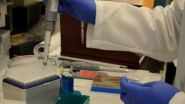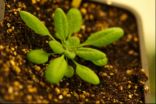(Press-News.org) Trypanosome parasites transmitted by tsetse flies cause devastating diseases in humans and livestock. Different subspecies infect different hosts: Trypanosoma brucei brucei infects cattle but is non-infectious to humans, whereas T. b. gambiense and T. b. rhodesiense cause sleeping sickness in humans. A study published on May 15th in PLOS Pathogens reveals how humans can fight off some trypanosomes but not others.
Sam Alsford, from the London School of Hygiene and Tropical Medicine, UK, and colleagues, undertook a comprehensive search for genes that make T. b. brucei sensitive to the innate (the first-line, non-specific) defenses of the human immune system. The hope is that understanding the molecular basis of sensitivity would enable the development of strategies to sensitize resistant trypanosome subspecies. And new drugs are badly needed because existing ones have serious side effects.
The researchers systematically inactivated T. b. brucei genes and looked for parasites which could survive exposure to human blood serum (factors in which can kill this subspecies, making it harmless to humans). Three genes thought to sensitize T. b. brucei to human defenses had been previously identified by other methods, and the researchers re-discovered all three—plus they found a previously unknown fourth gene in this study.
One of the known genes codes for a protein called inhibitor of cysteine peptidase (or ICP), and the researchers further analyzed its role. Using chemical and genetic approaches, they show that ICP sensitizes T. b. brucei to human serum by dampening the activity of a specific cysteine peptidase (a protein that can cut other proteins) called CATL. In the absence of ICP, CATL is fully active and can counteract components of human serum responsible for killing trypanosomes.
Discussing the findings, Alsford commented: "CATL is under consideration as a potential drug target, and our results suggest that its inactivation could indeed support the human defense system in fighting off disease-causing trypanosome strains. However, as CATL might also be involved in the generation or break-down of other factors involved in parasite-host interactions, it will be important to develop an improved understanding of the complex interplay of all of these factors in human-infective trypanosomes".
The researchers also plan work on the new (fourth) gene they discovered. It codes for a protein that appears to be a so-called transmembrane channel. Studying this channel (which is likely to be involved in the uptake of human defense factors by the parasite) should further improve the understanding of the interaction between the parasite and the anti-trypanosomal components of human serum.
INFORMATION:
Authors and Affiliations:
Sam Alsford, London School of Hygiene & Tropical Medicine, London, United Kingdom
Rachel B. Currier, London School of Hygiene & Tropical Medicine, London, United Kingdom
José Afonso Guerra-Assunção, London School of Hygiene & Tropical Medicine, London, United Kingdom
Taane G. Clark1, London School of Hygiene & Tropical Medicine, London, United Kingdom
David Horn, University of Dundee, Dundee, United Kingdom
Funding: This work was funded by a Wellcome Trust Institutional Strategic Support Fund (LSHTM) fellowship and the Medical Research Council/Department for International Development (project grant MR/K011987/1) to SA. JAG is supported by a Wellcome Trust grant (096249/Z/11/B). TGC receives support from a Medical Research Council UK programme grant (MR/J005398/1). DH is funded by a Wellcome Trust Senior Investigator Award (100320/Z/12/Z). The funders had no role in study design, data collection and analysis, decision to publish, or preparation of the manuscript.
Competing Interests: The authors have declared that no competing interests exist.
Citation: Alsford S, Currier RB, Guerra-Assunc¸a˜o JA, Clark TG, Horn D (2014) Cathepsin-L Can Resist Lysis by Human Serum in Trypanosoma brucei brucei. PLoS Pathog 10(5): e1004130. doi:10.1371/journal.ppat.1004130 END
How some trypanosomes cause sleeping sickness while others don't
2014-05-16
ELSE PRESS RELEASES FROM THIS DATE:
Walking may have profound benefits for patients with kidney disease
2014-05-16
Washington, DC (May 15, 2014) — For individuals with kidney disease, walking may help prolong life and reduce the risk of needing dialysis or a kidney transplant. That's the conclusion of a study appearing in an upcoming issue of the Clinical Journal of the American Society of Nephrology (CJASN).
Physical inactivity is common among patients with chronic kidney disease (CKD). Che-Yi Chou MD, PhD, Chiz-Tzung Chang, PhD (China Medical University Hospital, in Taiwan) and their colleagues looked to see if an activity as simple as walking might provide benefits to patients. ...
New tool to grow cancer cells streamlines laboratory research
2014-05-16
VIDEO:
Georgetown Lombardi Comprehensive Cancer Center researcher Anna T. Riegel, PhD, discusses a new technique that allows the growth of both normal and cancer cells and keeps them alive indefinitely is...
Click here for more information.
WASHINGTON — A new technique that allows the growth of both normal and cancer cells and keeps them alive indefinitely is transforming and expediting basic cancer research, say investigators from Georgetown Lombardi Comprehensive Cancer Center. ...
New kidney allocation policy could improve the success of transplantations in the US
2014-05-16
Washington, DC (May 15, 2014) — A newly approved US policy regarding allocation of kidneys from deceased donors will likely improve patient and transplant survival, according to a study appearing in an upcoming issue of the Journal of the American Society of Nephrology (JASN). The true effects of the new policy are yet to be seen, however, and officials will evaluate its intended and unintended consequences on an ongoing basis.
In 2013, the Organ Procurement and Transplantation Network in the United States approved a new national deceased donor kidney allocation policy ...
Novel genetic mechanism protects plants from toxic zinc
2014-05-16
Zinc is essential for optimal plant growth and development but when high levels of the metal are present in the soil, it can become toxic to the plant. Consequently, plants need to trigger mechanisms capable of coping with that stress. Researchers from the Instituto Gulbenkian de Ciência (IGC) have now discovered a novel genetic mechanism that protects plants from toxic zinc levels. The research team, led by Paula Duque, identified a gene that produces a protein capable of sequestering zinc inside the cells of the root. In the presence of high levels of zinc, this gene ...
Tumor cells in the blood may indicate poor prognosis in early breast cancer
2014-05-15
Tumor cells in bone marrow of early breast cancer patients predict a higher risk of relapse as well as poorer survival, but bone marrow biopsy is an invasive and painful procedure. Now, it may be possible to identify tumor cells in a routine blood sample and use them as prognostic markers, according to a study published May 15 in the Journal of the National Cancer Institute.
To assess the prognostic value of circulating tumor cells (CTCs) in patients with early breast cancer, Brigitte Rack, M.D., of the Department of Gynecology and Obstetrics, Klinikum Innenstadt, ...
Older migraine sufferers may have more silent brain injury
2014-05-15
DALLAS, May 15, 2014 — Older migraine sufferers may be more likely to have silent brain injury, according to research published in the American Heart Association’s journal Stroke.
In a new study, people with a history of migraine headaches had double the odds of ischemic silent brain infarction compared to people who said they didn’t have migraines. Silent brain infarction is a brain injury likely caused by a blood clot interrupting blood flow to brain tissue. Sometimes called “silent strokes,” these injuries are symptomless and are a risk factor for future strokes.
Previous ...
Study -- overweight teens more likely to be rejected as friends by normal weight peers
2014-05-15
Tempe, Ariz. (May, 15, 2014) - Overweight young people are more likely to be rejected as friends by peers who are of normal weight, according to new research by Arizona State University social scientists.
"Using Social Network Analysis to Clarify the Role of Obesity in Adolescent Friend Selection," published in the American Journal of Public Health by Arizona State University Associate Professors David R. Schaefer of the School of Human Evolution and Social Change and Sandra D. Simpkins of the T. Denny Sanford School of Social and Family Dynamics, used social network ...
2 JAMA Ophthalmology studies focus on glaucoma medication adherence
2014-05-15
Electronic monitoring to measure medication adherence by patients with glaucoma documented that a sizable number of patients did not regularly use the eye drops prescribed to them.
Topical medications for glaucoma lower intraocular pressure and can delay or slow the progression of the eye disease. Medication adherence is important.
Patients who were treated with once-daily prostaglandin eye drops were recruited from a university-based glaucoma clinic. Patients were given a container with an electronic cap in which to store their eye drops. The cap recorded each ...
NYC safe routes to school program reduces injuries and saves hundreds of millions of dollars
2014-05-15
As Bike to Work week continues, New Yorkers got some good news from a team of researchers at Columbia University's Mailman School of Public Health. Using funds from the federally funded Safe Routes to School program enacted in 2005 in an effort to create safe environments for American children to walk or bike to school, New York City made safety changes to the most dangerous intersections near schools. These interventions included narrowing intersections by building out sidewalks, setting off dedicated bicycle lanes, and installing speed humps, and timing lights so pedestrians ...
Study uncovers new evidence on species evolution
2014-05-15
A study involving Simon Fraser University researchers and published today in the journal Science has found evidence for the genomic basis of how new species evolve, in adapting to different environments.
Researchers studying an insect known as the walking stick (genus Timema) determined that the process of "speciation" happened in association with the use of different host plants. They also determined that across many populations of the insect, those on one host plant are diverging, genetically, from the populations on another host plant, a process they call "parallel ...

